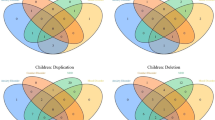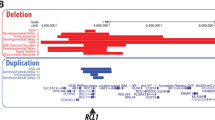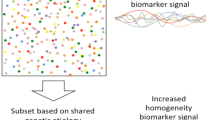Abstract
Microdeletions of chromosomal region 2q23.1 that disrupt MBD5 (methyl-CpG-binding domain protein 5) contribute to a spectrum of neurodevelopmental phenotypes; however, the impact of this locus on human psychopathology has not been fully explored. To characterize the structural variation landscape of MBD5 disruptions and the associated human psychopathology, 22 individuals with genomic disruption of MBD5 (translocation, point mutation and deletion) were identified through whole-genome sequencing or cytogenomic microarray at 11 molecular diagnostic centers. The genomic impact ranged from a single base pair to 5.4 Mb. Parents were available for 11 cases, all of which confirmed that the rearrangement arose de novo. Phenotypes were largely indistinguishable between patients with full-segment 2q23.1 deletions and those with intragenic MBD5 rearrangements, including alterations confined entirely to the 5′-untranslated region, confirming the critical impact of non-coding sequence at this locus. We identified heterogeneous, multisystem pathogenic effects of MBD5 disruption and characterized the associated spectrum of psychopathology, including the novel finding of anxiety and bipolar disorder in multiple patients. Importantly, one of the unique features of the oldest known patient was behavioral regression. Analyses also revealed phenotypes that distinguish MBD5 disruptions from seven well-established syndromes with significant diagnostic overlap. This study demonstrates that haploinsufficiency of MBD5 causes diverse phenotypes, yields insight into the spectrum of resulting neurodevelopmental and behavioral psychopathology and provides clinical context for interpretation of MBD5 structural variations. Empirical evidence also indicates that disruption of non-coding MBD5 regulatory regions is sufficient for clinical manifestation, highlighting the limitations of exon-focused assessments. These results suggest an ongoing perturbation of neurological function throughout the lifespan, including risks for neurobehavioral regression.
This is a preview of subscription content, access via your institution
Access options
Subscribe to this journal
Receive 12 print issues and online access
$259.00 per year
only $21.58 per issue
Buy this article
- Purchase on Springer Link
- Instant access to full article PDF
Prices may be subject to local taxes which are calculated during checkout


Similar content being viewed by others
References
Weiss LA, Shen Y, Korn JM, Arking DE, Miller DT, Fossdal R et al. Association between microdeletion and microduplication at 16p11.2 and autism. N Engl J Med 2008; 358: 667–675.
Jacquemont S, Reymond A, Zufferey F, Harewood L, Walters RG, Kutalik Z et al. Mirror extreme BMI phenotypes associated with gene dosage at the chqromosome 16p11.2 locus. Nature 2011; 478: 97–102.
Rosenfeld JA, Ballif BC, Lucas A, Spence EJ, Powell C, Aylsworth AS et al. Small deletions of SATB2 cause some of the clinical features of the 2q33.1 microdeletion syndrome. PLoS ONE 2009; 4: e6568.
Talkowski ME, Rosenfeld JA, Blumenthal I, Pillalamarri V, Chiang C, Heilbut A et al. Sequencing chromosomal abnormalities reveals neurodevelopmental loci that confer risk across diagnostic boundaries. Cell 2012; 149: 525–537.
Kleefstra T, Kramer JM, Neveling K, Willemsen MH, Koemans TS, Vissers LE et al. Disruption of an EHMT1-associated chromatin-modification module causes intellectual disability. Am J Hum Genet 2012; 91: 1–10.
Talkowski ME, Mullegama SV, Rosenfeld JA, van Bon BW, Shen Y, Repnikova EA et al. Assessment of 2q23.1 microdeletion syndrome implicates MBD5 as a single causal locus of intellectual disability, epilepsy, and autism spectrum disorder. Am J Hum Genet 2011; 89: 551–563.
Williams SR, Mullegama SV, Rosenfeld JA, Dagli AI, Hatchwell E, Allen WP et al. Haploinsufficiency of MBD5 associated with a syndrome involving microcephaly, intellectual disabilities, severe speech impairment, and seizures. Eur J Hum Genet 2010; 18: 436–441.
van Bon BW, Koolen DA, Brueton L, McMullan D, Lichtenbelt KD, Ades LC et al. The 2q23.1 microdeletion syndrome: clinical and behavioural phenotype. Eur J Hum Genet 2010; 18: 163–170.
Chung BH, Stavropoulos J, Marshall CR, Weksberg R, Scherer SW, Yoon G . 2q23 de novo microdeletion involving the MBD5 gene in a patient with developmental delay, postnatal microcephaly and distinct facial features. Am J Med Genet A 2011; 155A: 424–429.
Jaillard S, Dubourg C, Gerard-Blanluet M, Delahaye A, Pasquier L, Dupont C et al. 2q23.1 Microdeletion identified by array comparative genomic hybridisation: an emerging phenotype with Angelman-like features? J Med Genet 2009; 46: 847–855.
De Gregori M, Ciccone R, Magini P, Pramparo T, Gimelli S, Messa J et al. Cryptic deletions are a common finding in ‘balanced’ reciprocal and complex chromosome rearrangements: a study of 59 patients. J Med Genet 2007; 44: 750–762.
Vissers LE, de Vries BB, Osoegawa K, Janssen IM, Feuth T, Choy CO et al. Array-based comparative genomic hybridization for the genomewide detection of submicroscopic chromosomal abnormalities. Am J Hum Genet 2003; 73: 1261–1270.
Wagenstaller J, Spranger S, Lorenz-Depiereux B, Kazmierczak B, Nathrath M, Wahl D et al. Copy-number variations measured by single-nucleotide-polymorphism oligonucleotide arrays in patients with mental retardation. Am J Hum Genet 2007; 81: 768–779.
Koolen DA, Vissers LE, Nillesen W, Smeets D, van Ravenswaaij CM, Sistermans EA et al. A novel microdeletion, del(2)(q22.3q23.3) in a mentally retarded patient, detected by array-based comparative genomic hybridization. Clin Genet 2004; 65: 429–432.
de Vries BB, Pfundt R, Leisink M, Koolen DA, Vissers LE, Janssen IM et al. Diagnostic genome profiling in mental retardation. Am J Hum Genet 2005; 77: 606–616.
Chung BH, Mullegama S, Marshall CR, Lionel AC, Weksberg R, Dupuis L et al. Severe intellectual disability and autistic features associated with microduplication 2q23.1. Eur J Hum Genet 2011; 20: 398–403.
Pinto D, Pagnamenta AT, Klei L, Anney R, Merico D, Regan R et al. Functional impact of global rare copy number variation in autism spectrum disorders. Nature 2010; 466: 368–372.
Laget S, Joulie M, Le Masson F, Sasai N, Christians E, Pradhan S et al. The human proteins MBD5 and MBD6 associate with heterochromatin but they do not bind methylated DNA. PLoS ONE 2010; 5: e11982.
Bogdanovic O, Veenstra GJ . DNA methylation and methyl-CpG binding proteins: developmental requirements and function. Chromosoma 2009; 118: 549–565.
Tennessen JA, Bigham AW, O’Connor TD, Fu W, Kenny EE, Gravel S et al. Evolution and functional impact of rare coding variation from deep sequencing of human exomes. Science 2012; 337: 64–69.
Motobayashi M, Nishimura-Tadaki A, Inaba Y, Kosho T, Miyatake S, Niimi T et al. Neurodevelopmental features in 2q23.1 microdeletion syndrome: report of a new patient with intractable seizures and review of literature. Am J Med Genet A 2012; 158A: 861–868.
Noh GJ, Graham JM Jr. . 2q23.1 microdeletion of the MBD5 gene in a female with seizures, developmental delay and distinct dysmorphic features. Eur J Med Genet 2012; 55: 59–62.
O’Roak BJ, Vives L, Girirajan S, Karakoc E, Krumm N, Coe BP et al. Sporadic autism exomes reveal a highly interconnected protein network of de novo mutations. Nature 2012; 485: 246–250.
Chiang C, Jacobsen JC, Ernst C, Hanscom C, Heilbut A, Blumenthal I et al. Complex reorganization and predominant non-homologous repair following chromosomal breakage in karyotypically balanced germline rearrangements and transgenic integration. Nat Genet 2012; 44: 390–397, S391.
Talkowski ME, Ernst C, Heilbut A, Chiang C, Hanscom C, Lindgren A et al. Next-generation sequencing strategies enable routine detection of balanced chromosome rearrangements for clinical diagnostics and genetic research. Am J Hum Genet 2011; 88: 469–481.
Li H, Durbin R . Fast and accurate short read alignment with Burrows–Wheeler transform. Bioinformatics 2009; 25: 1754–1760.
Zweier C, Sticht H, Aydin-Yaylagul I, Campbell CE, Rauch A . Human TBX1 missense mutations cause gain of function resulting in the same phenotype as 22q11.2 deletions. Am J Hum Genet 2007; 80: 510–517.
Yagi H, Furutani Y, Hamada H, Sasaki T, Asakawa S, Minoshima S et al. Role of TBX1 in human del22q11.2 syndrome. Lancet 2003; 362: 1366–1373.
Verhagen JM, Diderich KE, Oudesluijs G, Mancini GM, Eggink AJ, Verkleij-Hagoort AC et al. Phenotypic variability of atypical 22q11.2 deletions not including TBX1. Am J Med Genet A 2012; 158A: 2412–2420.
Girirajan S, Rosenfeld JA, Coe BP, Parikh S, Friedman N, Goldstein A et al. Phenotypic heterogeneity of genomic disorders and rare copy-number variants. N Engl J Med 2012; 367: 1321–1331.
Miller DT, Adam MP, Aradhya S, Biesecker LG, Brothman AR, Carter NP et al. Consensus statement: chromosomal microarray is a first-tier clinical diagnostic test for individuals with developmental disabilities or congenital anomalies. Am J Hum Genet 2010; 86: 749–764.
Manning M, Hudgins L . Use of array-based technology in the practice of medical genetics. Genet Med 2007; 9: 650–653.
Chen RM, Lupski JR, Greenberg F, Lewis RA . Ophthalmic manifestations of Smith–Magenis syndrome. Ophthalmology 1996; 103: 1084–1091.
Greenberg F, Lewis RA, Potocki L, Glaze D, Parke J, Killian J et al. Multi-disciplinary clinical study of Smith–Magenis syndrome (deletion 17p11.2). Am J Med Genet 1996; 62: 247–254.
Gropman AL, Duncan WC, Smith AC . Neurologic and developmental features of the Smith–Magenis syndrome (del 17p11.2). Pediatr Neurol 2006; 34: 337–350.
Edelman EA, Girirajan S, Finucane B, Patel PI, Lupski JR, Smith AC et al. Gender, genotype, and phenotype differences in Smith–Magenis syndrome: a meta-analysis of 105 cases. Clin Genet 2007; 71: 540–550.
Smith AC, Dykens E, Greenberg F . Sleep disturbance in Smith–Magenis syndrome (del 17 p11.2). Am J Med Genet 1998; 81: 186–191.
Martin SC, Wolters PL, Smith AC . Adaptive and maladaptive behavior in children with Smith–Magenis Syndrome. J Autism Dev Disord 2006; 36: 541–552.
Gunay-Aygun M, Schwartz S, Heeger S, O’Riordan MA, Cassidy SB . The changing purpose of Prader–Willi syndrome clinical diagnostic criteria and proposed revised criteria. Pediatrics 2001; 108: E92.
Jin DK . Systematic review of the clinical and genetic aspects of Prader–Willi syndrome. Korean J Pediatr 2011; 54: 55–63.
Sinnema M, Maaskant MA, van Schrojenstein Lantman-de Valk HM, van Nieuwpoort IC, Drent ML, Curfs LM et al. Physical health problems in adults with Prader–Willi syndrome. Am J Med Genet A 2011; 155A: 2112–2124.
Vaiani E, Herzovich V, Chaler E, Chertkoff L, Rivarola MA, Torrado M et al. Thyroid axis dysfunction in patients with Prader–Willi syndrome during the first 2 years of life. Clin Endocrinol (Oxf) 2010; 73: 546–550.
West LA, Ballock RT . High incidence of hip dysplasia but not slipped capital femoral epiphysis in patients with Prader–Willi syndrome. J Pediatr Orthop 2004; 24: 565–567.
Hered RW, Rogers S, Zang YF, Biglan AW . Ophthalmologic features of Prader–Willi syndrome. J Pediatr Ophthalmol Strab 1988; 25: 145–150.
Williams CA, Driscoll DJ, Dagli AI . Clinical and genetic aspects of Angelman syndrome. Genet Med 2012; 12: 385–395.
Michieletto P, Bonanni P, Pensiero S . Ophthalmic findings in Angelman syndrome. J Aapos 2011; 15: 158–161.
Jackson L, Kline AD, Barr MA, Koch S . de Lange syndrome: a clinical review of 310 individuals. Am J Med Genet 1993; 47: 940–946.
Kline AD, Krantz ID, Sommer A, Kliewer M, Jackson LG, FitzPatrick DR et al. Cornelia de Lange syndrome: clinical review, diagnostic and scoring systems, and anticipatory guidance. Am J Med Genet A 2007; 143A: 1287–1296.
Levin AV, Seidman DJ, Nelson LB, Jackson LG . Ophthalmologic findings in the Cornelia de Lange syndrome. J Pediatr Ophthalmol Strab 1990; 27: 94–102.
Wygnanski-Jaffe T, Shin J, Perruzza E, Abdolell M, Jackson LG, Levin AV . Ophthalmologic findings in the Cornelia de Lange Syndrome. J Aapos 2005; 9: 407–415.
Neul JL, Kaufmann WE, Glaze DG, Christodoulou J, Clarke AJ, Bahi-Buisson N et al. Rett syndrome: revised diagnostic criteria and nomenclature. Ann Neurol 2010; 68: 944–950.
Percy AK, Lane JB . Rett syndrome: model of neurodevelopmental disorders. J Child Neurol 2005; 20: 718–721.
Smeets EE, Pelc K, Dan B . Rett syndrome. Mol Syndromol 2012; 2: 113–127.
Kleefstra T, van Zelst-Stams WA, Nillesen WM, Cormier-Daire V, Houge G, Foulds N et al. Further clinical and molecular delineation of the 9q subtelomeric deletion syndrome supports a major contribution of EHMT1 haploinsufficiency to the core phenotype. J Med Genet 2009; 46: 598–606.
Stewart DR, Kleefstra T . The chromosome 9q subtelomere deletion syndrome. Am J Med Genet C 2007; 145C: 383–392.
Willemsen MH, Vulto-van Silfhout AT, Nillesen WM, Wissink-Lindhout WM, van Bokhoven H, Philip N et al. Update on Kleefstra syndrome. Mol Syndromol 2012; 2: 202–212.
Marangi G, Ricciardi S, Orteschi D, Lattante S, Murdolo M, Dallapiccola B et al. The Pitt–Hopkins syndrome: report of 16 new patients and clinical diagnostic criteria. Am J Med Genet A 2011; 155A: 1536–1545.
Peippo M, Ignatius J . Pitt–Hopkins syndrome. Mol Syndromol 2012; 2: 171–180.
Van Balkom IDC, Vuijk PJ, Franssens M, Hoek HW, Hennekam RC . Development, cognition, and behaviour in Pitt–Hopkins syndrome. Dev Med Child Neurol 2012; 54: 925–931.
Curry CJ, Stevenson RE, Aughton D, Byrne J, Carey JC, Cassidy S et al. Evaluation of mental retardation: recommendations of a Consensus Conference: American College of Medical Genetics. Am J Med Genet 1997; 72: 468–477.
Acknowledgements
This work was funded by grants from the NIH GM061354 (CCM, JFG) and MH09586 (MET), and from the Fondation Jerome Lejeune (SHE). MET is also supported by the Simons Foundation for Autism Research, the Nancy Lurie Marks Family Foundation and NARSAD. We thank the patients and their families and physicians for participating in this study.
Author information
Authors and Affiliations
Corresponding authors
Ethics declarations
Competing interests
The authors declare no conflict of interest.
Additional information
Supplementary Information accompanies the paper on the Molecular Psychiatry website
Supplementary information
PowerPoint slides
Rights and permissions
About this article
Cite this article
Hodge, J., Mitchell, E., Pillalamarri, V. et al. Disruption of MBD5 contributes to a spectrum of psychopathology and neurodevelopmental abnormalities. Mol Psychiatry 19, 368–379 (2014). https://doi.org/10.1038/mp.2013.42
Received:
Revised:
Accepted:
Published:
Issue Date:
DOI: https://doi.org/10.1038/mp.2013.42
Keywords
This article is cited by
-
Oligogenic inheritance in severe adult obesity
International Journal of Obesity (2024)
-
Composite Sleep Problems Observed Across Smith–Magenis Syndrome, MBD5-Associated Neurodevelopmental Disorder, Pitt–Hopkins Syndrome, and ASD
Journal of Autism and Developmental Disorders (2021)
-
Transcriptional consequences of MBD5 disruption in mouse brain and CRISPR-derived neurons
Molecular Autism (2020)
-
Neuropsychiatric decompensation in adolescents and adults with Phelan-McDermid syndrome: a systematic review of the literature
Molecular Autism (2019)
-
Burden of de novo mutations and inherited rare single nucleotide variants in children with sensory processing dysfunction
BMC Medical Genomics (2018)



